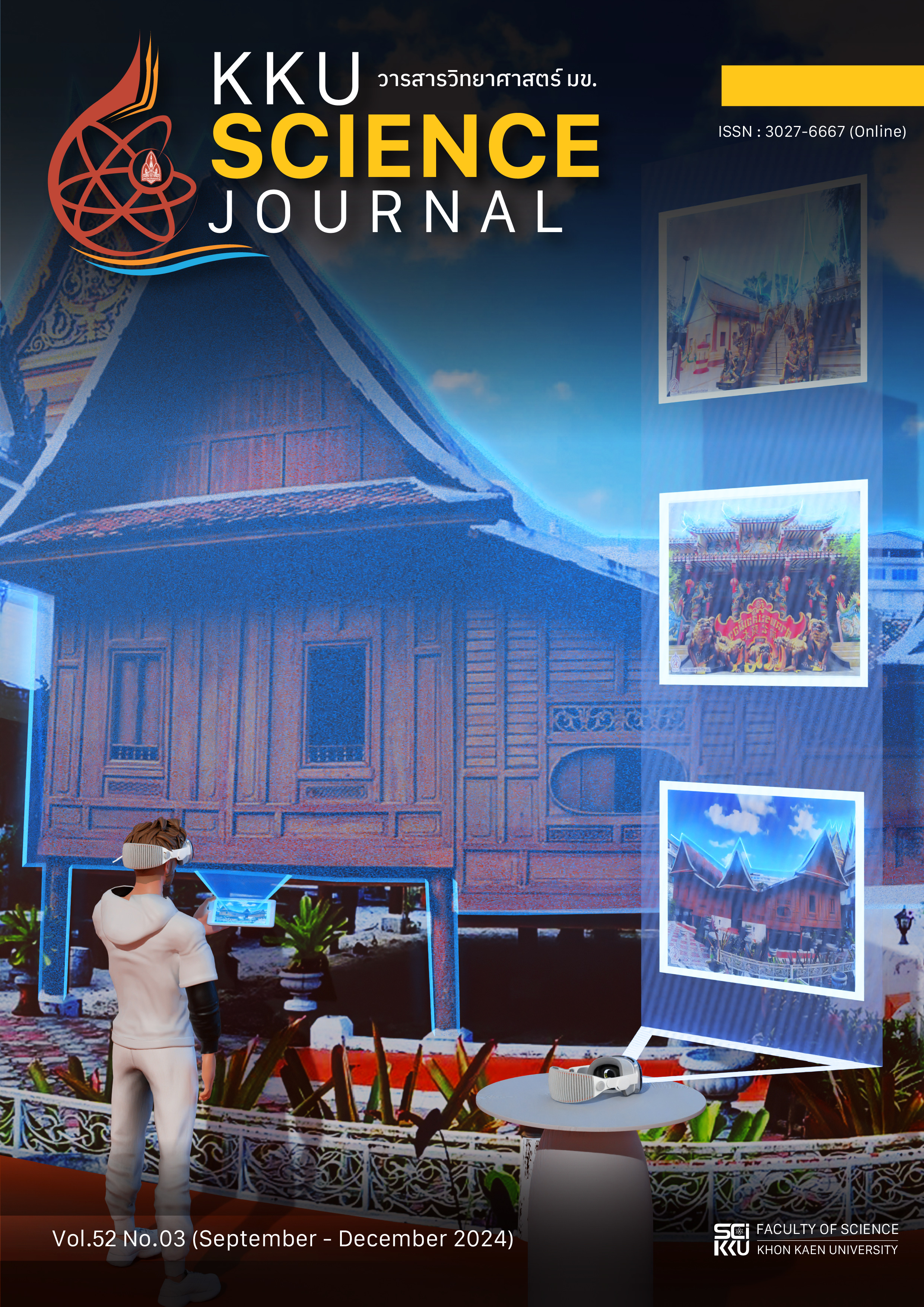The Virtual Museum of Wat Wang Tawan Tok for Cultural Heritage Learning
Main Article Content
Abstract
The objective of this research is to 1) develop and evaluate the effectiveness of a virtual museum of Wat Wang Tawan Tok for cultural heritage learning and 2) assess the satisfaction of users of the virtual museum of Wat Wang Tawan Tok. The sample population consists of 25 residents of Nakhon Si Thammarat Province for evaluating the platform's effectiveness and 80 residents living within the Nakhon Si Thammarat municipal area for assessing user satisfaction. The research tools include: 1) the virtual museum of Wat Wang Tawan Tok for cultural heritage learning, 2) a questionnaire to measure the effectiveness of the virtual museum of Wat Wang Tawan Tok, and 3) a questionnaire on user satisfaction with the virtual museum of Wat Wang Tawan Tok. The data were analyzed using descriptive statistics (i.e. mean and standard deviation). The research findings are as follows: 1) The virtual museum of Wat Wang Tawan Tok for cultural heritage learning comprises 3 components: (1) media (including AR, VR, and MR content), (2) presentation and (3) interaction. The overall effectiveness of the Wat Wang Tawan Tok for cultural heritage learning was found to be high with an average score of 4.46, and 2) the overall satisfaction of users of the Wat Wang Tawan Tok for cultural heritage learning was found to be extremely high with an average score of 4.83.
Article Details

This work is licensed under a Creative Commons Attribution-NonCommercial-NoDerivatives 4.0 International License.
References
กฤษณพงศ์ เลิศบำรุงชัย. (2565). การสร้างจักรวาลนฤมิต Spatial Metaverse. แหล่งข้อมูล: https://touchpoint.in.th/ spatial-metaverse. ค้นเมื่อวันที่ 16 กุมภาพันธ์ 2565.
เจริญ รุ่งกลิ่น, ธนวัฒน์ ชินสำราญวงศ์, กิตติภูมิ แซ่ลิ่ม และรามิลศร เชาว์ช่าง. (2562). การพัฒนาเว็บไซต์พิพิธภัณฑ์เมืองหาดใหญ่แบบเสมือนจริง. ใน: การประชุมหาดใหญ่วิชาการระดับชาติและนานาชาติ ครั้งที่ 10. มหาวิทยาลัยหาดใหญ่, สงขลา. 687 - 698.
ประภัสสร โพธิ์ศรีทอง. (2565). ปัญหาของพิพิธภัณฑ์ท้องถิ่น. แหล่งข้อมูล: https://www.gotoknow.org/posts/398529. ค้นเมื่อวันที่ 27 กุมภาพันธ์ 2565.
พรรณปพร บุญแปง และชรัณ ลาภบริสุทธิ์. (2565). พิพิธภัณฑ์: นิยามที่มากกว่าห้องเก็บของ. แหล่งข้อมูล: https://theurbanis.com/public-realm/07/04/2022/6432. ค้นเมื่อวันที่ 16 เมษายน 2565.
พิจิตรา จอมศรี. (2560). การเผยแพร่ภูมิปัญญาด้านจิตรกรรมฝาผนังบนเกาะรัตนโกสินทร์ด้วยระบบพิพิธภัณฑ์เสมือนจริง. วารสารมนุษยศาสตร์ สังคมศาสตร์ และศิลปะ 10(1): 1028 - 1041.
สุชาติ แสนพิช, พัฒนา ศิริกุลพิพัฒน์ และพิสิษฐ์ ณัฐประเสริฐ. (2563). การพัฒนาแอปพลิเคชันพิพิธภัณฑ์เสมือนปฏิสัมพันธ์ โดยใช้เทคโนโลยีสภาพแวดล้อมเสมือนในมุมมอง 360 องศา และการสแกนภาพสามมิติ: กรณีศึกษา 10 พิพิธภัณฑ์ของไทย. วารสารสารสนเทศศาสตร์ 38(1): 42 - 57.
สุรเชษฐ์ แก้วสกุล, บัญชา พงษ์พานิช และประสงค์ จิตต์มนัส. (2561). คัมภีร์พระนิพพานโสตร ตำนานแห่งพระบรมธาตุเมืองนคร และนานาของดีที่วัดวังตะวันตกกลางเมืองนคร. นครศรีธรรมราช: พิมพ์ดี.
อธิษฐ์ คู่เจริญถาวร และสรชัย ชวรางกูร. (2565). การพัฒนาพิพิธภัณฑ์เสมือนจริงด้วยเทคโนโลยี ความเป็นจริงเสริม เรื่อง กรุงศรีอยุธยาในฐานะเมืองท่า. วารสารวิชาการอยุธยาศึกษา 14(2): 103 - 116.
Agarawala, A. and Lee, J. (2017). Spatial. แหล่งข้อมูล: https://www.spatial.io. ค้นเมื่อวันที่ 16 ธันวาคม 2565.
Best, J.W. (1977). Research in Education. (3rd ed.). Englewood Cliffs. New Jersey: Prentice Hall, Inc.
Patel, H. and Cardinali, R. (2018). Virtual Reality Technology in Business. Management Decision 32(7): 5 - 12.


